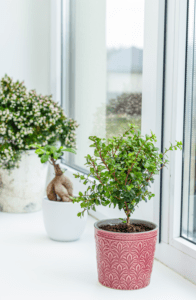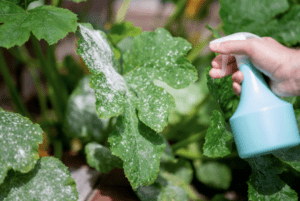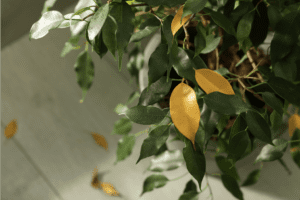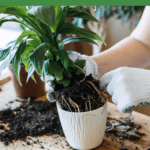December 11, 2023
7 Common Houseplant Ailments & How to Fix Them
7 Common Houseplant Ailments & How to Fix Them
Winter weather and long nights mean changes for humans, animals, and plants. Including our houseplants!
If you love your houseplants, seeing them covered in mildew, yellowing, infested with spider mites, or dropping leaves can be a huge bummer. And not knowing what’s wrong or how to help them can stress out any plant parent.
Luckily, understanding the signs of common houseplant issues just takes a bit of attention and treatment can be simple. Should you ditch a plant with root rot? Is powdery mildew a fungus? Let’s look at a few common problems with houseplant health and how to address them.
Preventing Houseplant Issues
Just like us, our plant companions need certain conditions and nutrients to stay healthy, and they succumb more easily to illness if those conditions aren’t met.
Plants can become “sick” for lots of reasons: caused by invasions by viruses, fungi, bacteria, and parasitic insects; from lack of nutrients; or because of generally unhealthy growing conditions. And while plant ailments are caused by different things, the best way to prevent and treat anything going on with your plant is to make sure you’re caring for them properly. Good overall health of a plant is the best prevention for any ailment.
Taking good care of your plants means:
- Not over-watering or under-watering
- Being sure plants are placed in a location with proper sunlight exposure, water drainage, and air circulation
- Keeping a plant’s environment at proper humidity level
- Giving plants proper nutrients from organic soil and fertilizer
- Cleaning and sanitizing garden tools (like shears, spades, and pots) between plants
- Making sure you buy disease-free plants so as not to infect your existing plants.
Heading into winter? Check out our guide to winterizing your houseplants.
What about fungicides?
We don’t recommend using chemical fungicides, not only because of how pricey they are, but because using those chemicals in your home can be harmful for you and your pets. There are plenty of ways to treat all of these conditions with practices and ingredients that are completely safe for your family, plants, and the planet.
Fungal Diseases
Root Rot
Root rot is a common plant ailment that can be caused by several different kinds of fungi. It typically results from overwatering. Excess water creates an environment conducive to fungal growth, which can lead to the roots deteriorating.
Signs of root rot include yellowing leaves, wilting, and stunted growth. You might also notice a foul smell or black, mushy roots when you remove the plant from its pot.
Stems and leaves may also show wilting and softness due to these same fungal infections, which is why root rot and stem rot can go hand-in-hand.
How to fix it: Don’t overwater; if your plants are sitting in water, that’s a fast road to root rot. If only a few roots are infected, you can cut them out and repot the plant in sterile soil. Always use sterilized soil and pots so you don’t spread disease between plants.
Powdery Mildew
Powdery mildew is a common fungal disease that affects pretty much every kind of plant. It appears as a white or grey powdery substance on the leaves and stems. It often occurs in conditions of high humidity and poor air circulation. Besides its unsightly appearance, powdery mildew can weaken plants and stunt their growth.
There are several kinds of fungus that cause powdery mildew but they all typically come from fungi living in dead plant material or from airborne spores that might come from outside.
How to fix it: Clip off the affected leaves. Since powdery mildew thrive in humid conditions, move your plants to a place with better ventilation or otherwise decrease the humidity in some other way. Make sure you’re not overwatering. You can use a sulfur spray to help reduce powdery mildew from spreading.
Anthracnose
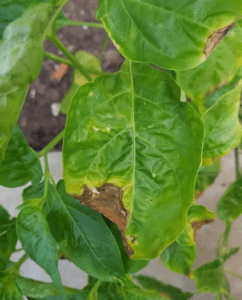
How to fix it: Snip off and destroy infected leaves. A gentle spray of soap water can help reduce future powdery mildew infection.
Environmental Conditions
Oedema
Oedema starts showing with rough corky swellings on leaves and petioles (the part of the plant that connects leaf to stem). After that, leaves may turn yellow and eventually droop and fall off. These swelling are actually caused by too much moisture, getting trapped in the plant.
So, as you can imagine, over-watering and poor lighting with low temperatures predispose plants to oedema. This happens commonly and unsurprisingly in succulents.
How to fix it: Leaves showing symptoms of oedema will sadly not recover, but you can halt the plant’s decline by improving light and watering habits. Repotting to improve soil drainage may also help severe cases.
Leaf Drop, Yellow, & Wilting
General plant malaise, especially wilting and yellowing, is usually an environmental or care-taking issue.
Wilting: Wilting is most likely…you guess it: inadequate or excess water. It can also mean a nutrient overload or that a plant’s pot is too small for it. Roots likely aren’t getting enough oxygen, so you need to provide drainage, reduce watering, and be sure your plant’s roots have room. Don’t fertilize it until it’s healthy.
Shock from significant change in environment can also cause wilting.
Yellowing: Yellowing all over is another sign of general illness, perhaps caused by overwatering, parasites, or lack of light. Check for drainage and root rot, re-pot if necessary. Be sure to give your plant enough sunlight.
Bud drop: If your plant loses flower buds prematurely, it may need a dose of fertilizer, especially nitrogen.
Pests
Spider Mites
These tiny pests can cause significant damage. As they eat plant sap, yellow spots or stippling appears on leaves. Some leaves may even fall off. Spider mites thrive in dry, dusty conditions, so keeping your plant’s environment clean and adequately humid can help deter them. Treat infestations by washing the plant with soapy water and using a miticide if necessary.
How to fix it: Treat infestations by washing the plant with soapy water and using a miticide if necessary. The best way to treat an infestation is to nip it in the bud, so inspect plants frequently, looking for white or yellow spots (which are easiest to see with a magnifying glass or hand lens). Consider covering the infested plants with bags as you treat them, to avoid the infestation spreading to adjacent plants.
Aphids
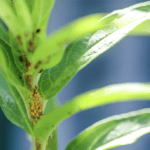
Aphids don’t only destroy your plants by sucking their sap, they also exude a sweet substance that attracts other pests and build up gunk on a plant’s surface that will prevent light from being absorbed. Bad news all around!
How to fix it: Small colonies of aphids are easy enough to pick off and crush. If squishing doesn’t work for you, drop them in a container of soapy water and dispose. If your infestation is growing, spray off with a stream of water and check on the overall health of your plant. Or, if you’re struggling with aphids in your outdoor garden, try introducing beneficial pest-eating insects like ladybugs or lacewings by placing pollinator plants in your garden, which attract friendly bugs.
Caring for Houseplants = Caring for You!
Indoor plants bring us joy, fresh air, and beauty. It’s not surprising that there’s increasing scientific research backing up what so many of us plant-lovers already know: being around green friends is healthy for us — in all kinds of ways. Taking care of plants just feels good.
Yes, you can keep houseplants alive! Go you!
The best way to protect your houseplants from illnesses and parasites is to give them plenty of attention and thoughtful care. Rich soil and organic nutrients, just the right amount of water, and balanced humidity and airflow. Just like you’d take care of yourself or a loved one: let the process of taking care of your houseplants encourage you to slow down and enjoy the joy they bring to your life and home.
(And don’t over-water!)
Show us your True Organic Plants
#GrowWithTrue
www.trueorganic.earth

